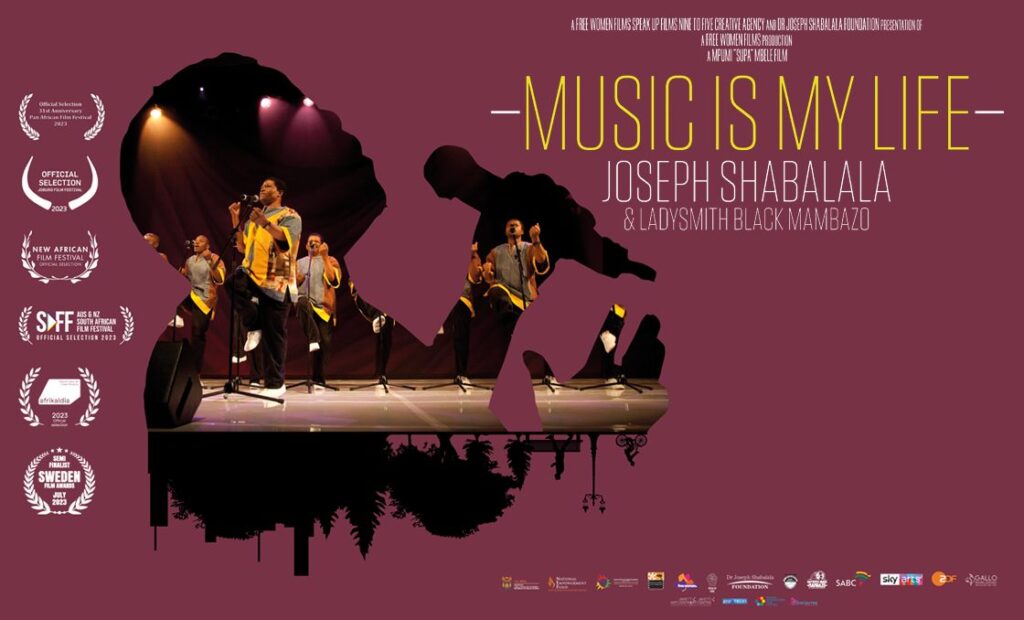The late music icon Joseph Mshengu Shabalala’s last wish revealed in a new biopic: Establishment of a school of traditional music named after him
The Oscar nominated biopic titled Music Is My Life – Joseph Shabalala and Ladysmith Black Mambazo was screened to critical acclaim to a select audience at Atlas Studios in Milpark Johannesburg on Wednesday, December 4, 2024.
By Edward Tsumele, CITYLIFE/ARTS Editor
I just remembered that when the first installment of the first Wednesday, a series of film screenings was announced at Atlas Studios in Milpark 20 years ago, I was there. But as they say, life happens. Ever since I may have attended one or two more of these screenings, after which the screenings and I drifted apart, going our separate ways.
However, this week, on Wednesday, 4 December 2024, I was one of the people who took a seat next to a friend who actually invited me to the last screening for this year as the screenings are taking a break till next year. But this was not just another screening of an ordinary film.
This was indeed a special occasion anyone who is a fan of this hugely popular isicathamiya group that rose from the rural backwaters of KwaZulu-Natal, the farms, to become a global success story of creative inspiration since the 60s, and whose music was appreciated in corridors of power, locally and globally, should have attended.
Ladysmith Black Mambazo under especially under the leadership of the now late Joseph Mshengu Shabalala became a global phenomenon in music over the years, whose artistic dexterity and flair were appreciated and whose collaboration was sought by the mighty and powerful from around the world. Such as the mighty Michael Jackson, Paul Simon, and Dolly Parton among other people of global artistic influence.
The journey from the farms of Kwa-Zulu-Natal to posh studios in London and the US, as well as performing on prestigious stages of the capitals of the world by Shabalala and his group, mainly his children and brother, is well captured in a powerful biopic Music Is My Life – Joseph Shabalala and Ladysmith Black Mambazo.

That is the reason why I found myself on Wednesday taking a seat in the screening room at Atlas Studios alongside other film enthusiasts, including filmmakers and journalists. We were there to watch a mighty story that captures the journey of Shabalala and Ladysmith Black Mambazo. After the completion of its run, the room erupted in appreciation of not only the musical success of Ladysmith Black Mambazo, but the aesthetic value embedded in the telling of this story by the filmmakers.
And to coin it all, not only is this film rich with the excavation of iconic archival material that the filmmakers have meticulously curated and assembled to articulate well the journey travelled by Shabalala and Ladysmith Black Mambazo, such as audio and videos of the group performing and recording all over the world, but also contextualising the journey through interviews with prominent South Africans.
In this case, those interviewed displayed immense insights into the career and art practice of Shabalala and Ladysmith Black Mambazo. I think that music icon Sipho “Hotstix” Mabuse, internationally renowned South African jazz pianist and music academic Dr. Nduduzo Makhathini, anthropologist Dr. Sipho Sithole and classically trained soprano Linda Bukhosini, who is also the artistic director and chief executive officer of The Playhouse in Durban, weaved a coherent and well considered context in which the artistry of Shabalala and Ladysmith Black Mamabazo shone bright and thrived do immense heights globally. The filmmakers could not have chosen better subjects in South Africa to give this insightful context.
However, the filmmakers explained that it was not easy to create this documentary which was South Africa’s chosen film for the Oscars for last year. Even though it did not win an Oscar, it won our hearts on Wednesday, and I suppose that at the end of the day, that is what matters -the most -being appreciated by the home audience that is very much connected to the music of Ladysmith Black Mambazo.
The documentary actually follows and crafts the journey of Shabalala from the 1960s right till the end of his life. I was particularly touched by one scene towards the end of the great musician’s life. Wheel-chair bound and shot in a sort of piece of grassland, which is the traditional home of the Shabalalas in Ladysmith. The musician is poignantly captured saying his last wish just as he realised his own demise was imminent.
Suffering from a recurring backpain after undergoing an operation: And that is that he would love to see a school established to teach traditional music named after him. I actually think those who hold the purse strings such as the department of Sport, Arts and Culture should really honour this great man’s wish and build such a school. This is where those who advise Minister Gayton McKenzie must come in and whisper in the minister’s ear to prevail on this issue. I do not think many South Africans would complain that funds used for that purpose out of his R6 billion budget, would be wasteful expenditure.
After all, this is a choral group that has behind its name five Grammys.Music Is My Life – Joseph Shabalala and Ladysmith Black Mambazois directed by the hugely talented filmmaker Mpumi Supa Mbele, who dished the rather comfortable commercial production space for the rather difficult and fickle film industry whose financial security for the practitioners is uncertain but rewarding in other ways when well done.
The producer is Carolyn Carew who told the audience that completing this biopic that took six years was not a walk in the park as it became an expensive journey and has left the crew owing everyone, particularly the National Empowerment Fund, the Industrial Development Corporation and Gallo among others.
Those with big pockets can feel free to approach the filmmakers and buy Music Is My Life – Joseph Shabalala and Ladysmith Black Mambazo, so that they can pay those they owe, Carey intimated during the Question and Answer segment after the screening.










